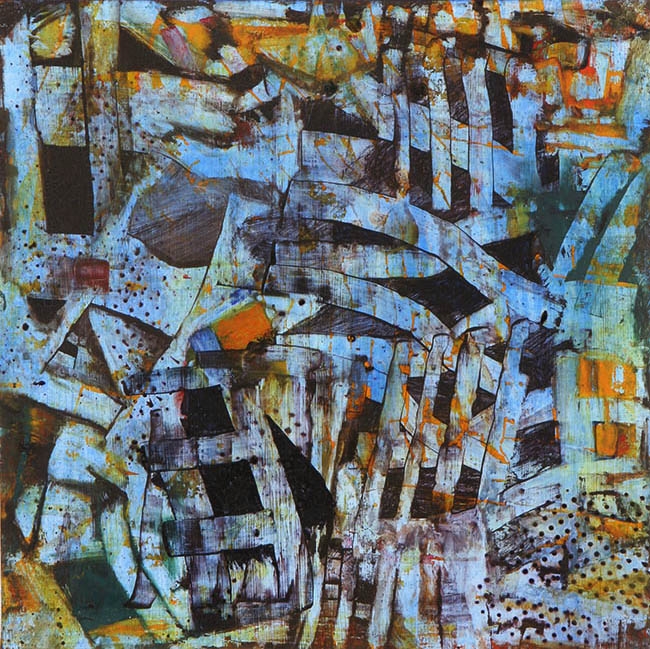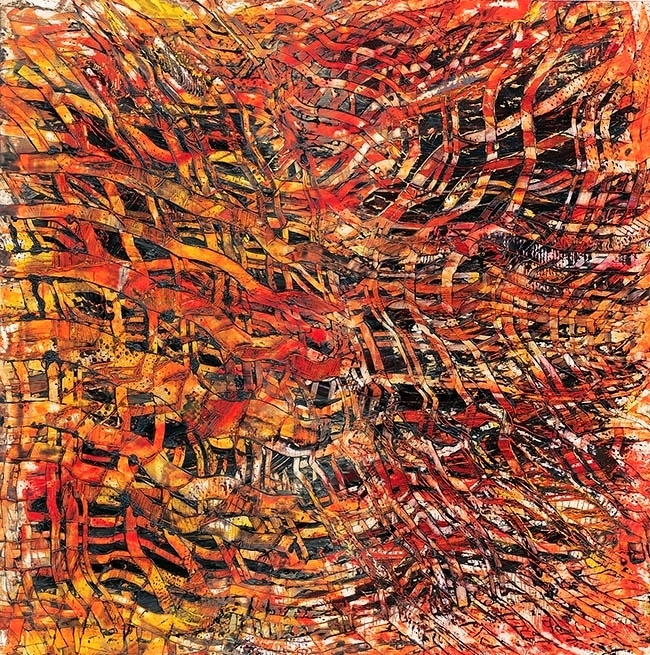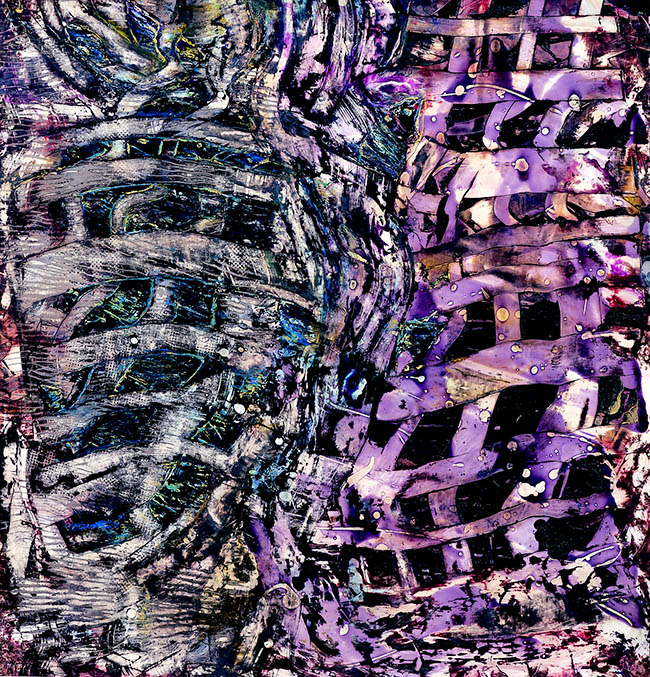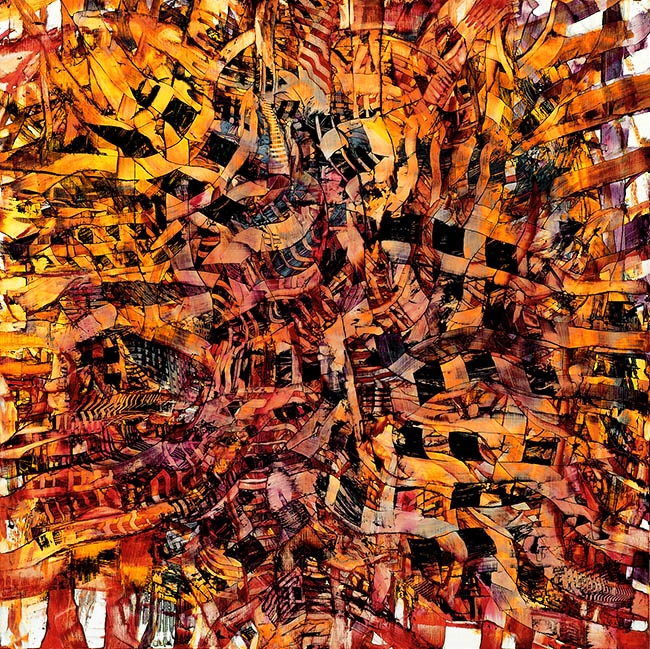Catalogue Essay
jeffrey hoffeld, 2003
IF YOU DESIRE TO REACH OUT INTO THE INFINITE, MOVE IN ALL DIRECTIONS IN THE FINITE.
Goethe, 1815
Linda Schrank's new paintings place before us a rich visual feast. Providing a complex record of gestures and turns of mind within their self-contained, finite world, each painting on wood or paper also leads us from the self-referential to the more universal, and from the closed system within each picture to a wider, more open worldview. While they celebrate the properties and pleasures of painting, these works also turn outward, absorbing and reflecting currents well beyond the walls of the studio. Several of these paintings were brought to life during Level Orange alerts. Others were completed while the fire-bombing of Iraq was broadcast in "living color."
BONNARD'S CARRYING THE EYE BACKWARD AND FORWARD MAY BE THOUGHT...A WAY OF EXPANDING AND CONTRACTING THE PAINTING AS IF IT WERE PULMONARY.
JOHN ELDERFIELD, 1998
Working, initially, on the floor, using handmade combs, rather than conventional brushes, Schrank applies layers of oil paint to wood supports. Giving herself over, physically, to the making of each work, she brings about an intertwining of vision and motion, as Merleau-Ponty described the transubstantiation of the material world into painting. Proceeding in an orderly fashion, one layer of paint at a time is set down. Each layer is allowed to dry before the next is applied, preventing any one layer from fusing with and redefining the next. In this way air is permitted to circulate among the grid-like warp and woof patterns formed by Schrank's insistent combings. As a result each painting appears exceedingly dense, while they are, at the same time, remarkably transparent. Although Schrank's methodical process accounts, in part, for the legibility of what we see before us, this painstaking technique is, for her, essentially a point of departure, setting the stage for the exploration of where each painting will take her.
The lines create a weave and tangle with each other, but air continues to circulate. My wish has always been to create paintings which appear like breathing made visible.
Linda Schrank, 2003
One may well ask, then, how does she keep it all straight? In fact, she doesn't pretend to keep it all straight; nor is it in any way her ambition to do so. The ultimate character of each work is not mapped out, understood, or somehow envisioned beforehand. Instead, the moderately controlling means of making these paintings give way to an unbridled play of unpredictable effects. These fortunate paintings, as Wallace Stevens referred to works in which there is a synthesis of exceptional concentration, reconcile orderly techniques and processes with elements of surprise and excitement created by spontaneously generated, unforeseen incidents and nuances. Nourished by the unconscious, subjected to a variety of unplanned physical influences (the painter's movements, the behavior of the materials), each painting has deposited within it intentionally undisguised evidence of accidents, missteps, discontinuities, and glimpses of roads not taken.
As Rosalind Krauss has pointed out, there is a tendency (some would take it to be a risk, in fact), when using a grid, for the work of art in question to appear to be a mere fragment, a tiny piece arbitrarily cropped from an infinitely larger fabric. There is, admittedly, a suggestion in the name Schrank has given to this series of works, To the Four Corners, that the artist's gestures and combing motions, and, as a consequence, the viewer's eye, all move, inevitably, to the outer edges of each work. Were this the case, it would mean that each work might, indeed, appear to be a fragment or swatch, as it were, of something greater, lying outside the boundaries of the respective painting. Although this may, at first, appear to be the case in certain works, such as By Day, Night, upon further reflection it becomes obvious that one's eye is actually kept in flux, moving restlessly between the center and the edges of these paintings, from inside to outside, and back again, forming the pulsating, irregular rhythmic breathing made visible in these works.
Robust physicality is a prevailing feature of these paintings, resulting, in part, from the apparent abandon with which Schrank enters, bodily, into the act of painting: the combs, themselves like weaving implements, plied across the surfaces; the insistent stretching out and pushing through to the corners; and the dynamic disorder of vigorously pulsating rhythms. These paintings also assert themselves physically through the emotional register or pitch of each work: their enraptured qualities; the ecstasy of movement recorded in each; and their nearly delirious, whirling dervish-like self-absorption. However, there are also anxiety-producing ingredients. The feverish interlacing and swirling/whirling/swooning of works like Woven and Woven are transporting, as well as disquieting. Unchartable motions and commotions produce a sense of release, of letting go, while they also stir up, no less convincingly, fears of entrapment, of being pulled into the maelstrom and swept away, snared, enmeshed. Direction and outcome are unknown. The breathing here is hastened, hectic, frenetic.
Feelings of uneasiness and uncertainty arise. There are likely to be some viewers for whom such sensations may actually dominate their experience of these paintings. Schrank's use of color contributes to this mood of uncertainty and emotional ambiguity. It is difficult, for one thing, to accurately describe her colors. They can be irritating and disturbing. Elsewhere, they are more inviting, lush, even sensuous, but they remain essentially unnameable. Should each color be compared, then, to that of a specific flower, or to whole fields, recklessly furrowed and seeded? Are the feathers of certain exotic birds analogous? Does Schrank have in mind the other-worldly vestments of angels and martyrs in beloved Italian paintings? Or, am I on to something when I find her colors closest to the oddly seductive pools of fluorescent toxic chemicals and stagnant ponds full of industrial wastes beside commuter railway lines, or those too-beautiful-for-words sunsets, pumped up and in-painted with poisonous gases?
The element of time plays an important role in the emotional tone of these paintings. One senses a pressing forward in time, an emergence, something along the lines of what Meyer Schapiro detected in van Gogh's wheat fields as a growing imminence of the next moment..like an ominous fate approaching. These impressions, informed, in part, by Schrank's titles-Deep in the Eye;Angels and Demons-are strongly reinforced by the massing up and concentration of color within the serpentine skeins of several paintings. These especially dense, impenetrable zones, contain tell-tale signs of a lurking, even watchful, human presence, woven into the fabric of the paintings, deeply embedded and cocooned within their mysterious fields.Too vague to pin down, but in their proportions and general configurations they are unmistakably figurative. Consider the possible word play: loom, as both the word for a frame or machine used in weaving, and, when used as a verb, as in to loom or looming, meaning to take shape, portend.








